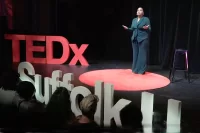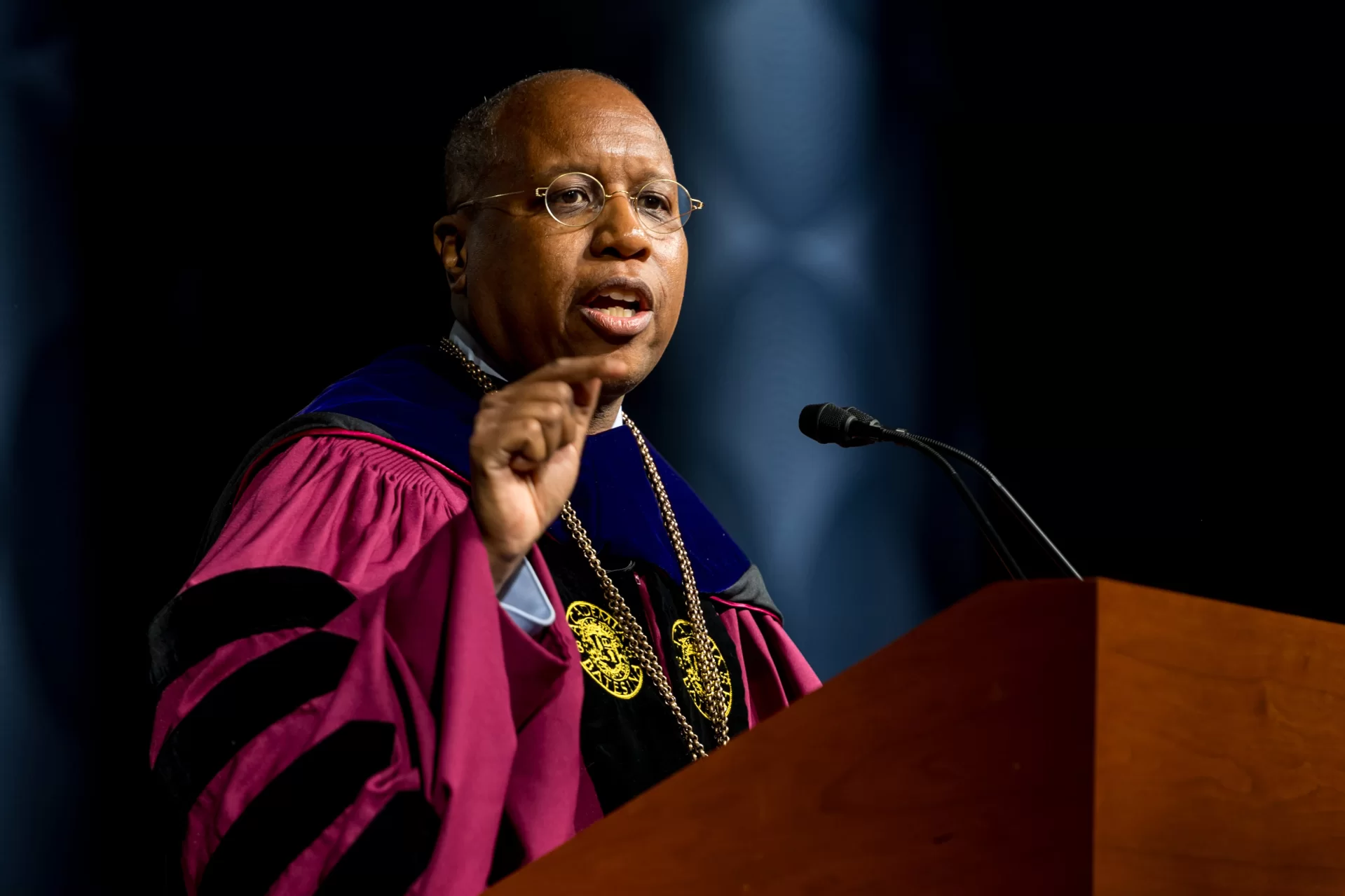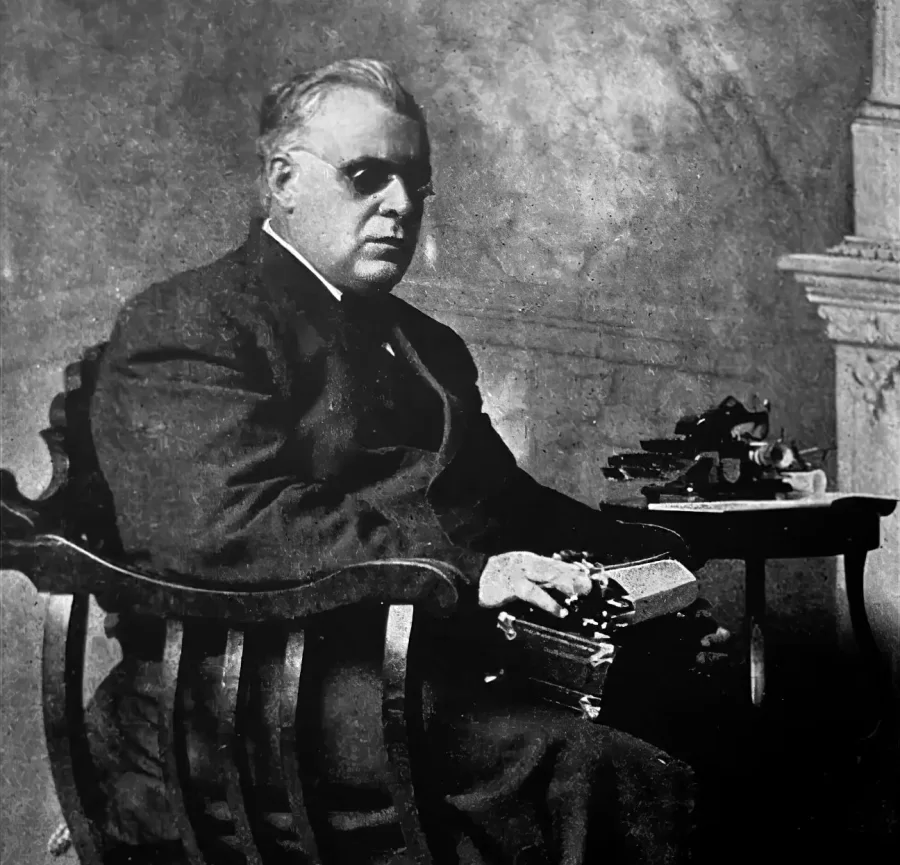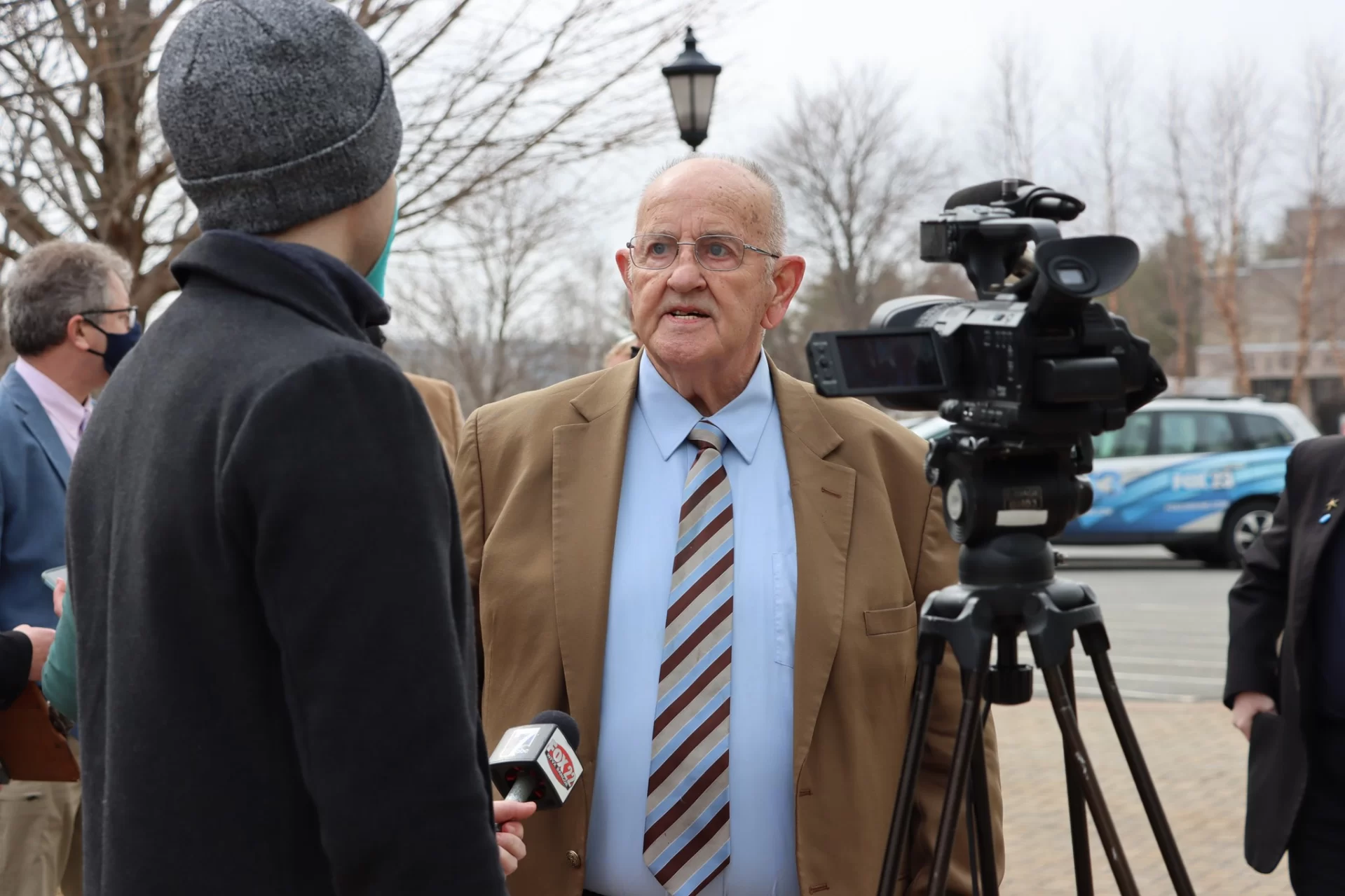
A selection of recent mentions of Bates and Bates people in the news.
The Bates Campus:
President Garry W. Jenkins
What’s the role of college presidents in fostering civic engagement for democracy? — Forbes
Forbes quoted Bates President Garry W. Jenkins in a news story about the more-than 60 college and university presidents who “are uniting to foster democracy and civic engagement” by joining College Presidents for Civic Preparedness.
“The ability to manage disagreement while seeking common ground and pursuing productive solutions is critically important in a democracy. Today, unfortunately, our society is in urgent need of developing such essential skills,” Jenkins told Forbes.

“It’s clear to me that both our nation’s K–12 schools and higher education must develop, promote, and nurture the democratic skills and values of tolerance, pluralism, negotiation, and respect for different views.”
Bates Commencement
Bates College’s newest graduates recall struggles, triumphs — Sun Journal
The Sun Journal’s coverage of Commencement included interviews with a number of seniors, including Mfon Diduff, a biological chemistry major from Brooklyn, N.Y., who said she feels privileged to have been able to do groundbreaking research during her four years.

Reporter Kendra Caruso noted that Diduff offered advice to incoming first-year Bates students. “Everyone is unique,” the graduate said. “Everyone’s definition of success is not linear. I most strongly believe that whatever you find successful is a success. Do not measure your success to anyone else or to any other standard of society.”
BatesCon
Photos: BatesCon offers competition and comradery on campus — Sun Journal
Sun Journal photographer Russ Dillingham stopped by the first BatesCon, held May 18 and sponsored by the Bates Discordians club. The event was a free-to-enter convention celebrating everything related to board and video games, art, food trucks, and more.
“It was the first year for the free, public event that featured interactive activities throughout the day, speakers, panels and advice from professionals in the gaming industry,” wrote Dillingham.
Jessica Anthony ’96
A novella packing all the imagery and storytelling power of a novel — Kirkus Reviews

Praise is pouring in for The Most, the new novel by Lecturer in English Jessica Anthony ’96:
- Kirkus: A starred review for creating “a sharply focused portrait of seemingly average lives in midcentury America [that] reveals the complexities of those lives in the course of one balmy day.”
- Publishers Weekly: A coveted starred review, which called the book “sensational.”
- The Boston Globe: Inclusion on its list of “75 books we’re most excited to read this summer,” describing the novel as a “psychologically acute read…with a vivid sense of time and place.”
- Lit Hub: Inclusion on its list of 18 must-reads for the summer. “The whole thing has the extraordinarily pleasurable texture of gossip, wrapped up in the slightly eerie texture of a [John] Cheever story,” said reviewer Emily Temple.
- Vogue: Placement of the novel’s cover in “The Get,” the magazine’s two-page feature, directing readers to enjoy summer weekends by “loosening up, logging off, and diving in with breezy separates and accessories.” The novel was in close proximity to a $328 summer frock and a pair of $1,750 shorts.
Jeffrey Oishi
The Sun’s magnetic field might only be skin deep — Space Weekly
Space Weekly reported how solar physicists once thought the magnetic dynamo was deep inside the Sun. That view may change thanks to work by researchers including Bates Associate Professor of Physics Jeffrey Oishi and colleagues at MIT, the University of Edinburgh, the University of Colorado, Northwestern University, and the University of California.
Mara Tieken
70 years after Brown v. Board of Education, many schools remain segregated — ABC News
ABC News quoted Associate Professor of Education Mara Tieken in a story about how U.S. public schools across the country remain segregated seven decades after the landmark Brown v. Board of Education decision.
Part of the reason is the rise of what were once called “segregation academies”: white-only private schools in the South. While federal court decisions over time now require such schools to be open to non-white students, they have remained overwhelmingly white.
The segregation academies “were basically a place to educate white children and keep the school system white, and so what they did over time was they ended up draining enrollment from the [public] schools,” said Tieken.
Carrie Diaz Eaton
Can mathematicians help to solve social-justice problems? — Nature
An article published in Nature turns to Associate Professor of Digital and Computational Studies Carrie Diaz Eaton to help explain how scholars in mathematics and related disciplines are using their expertise to tackle major social issues, such as social inequality and the need for gender equity.
Diaz Eaton is executive director of the Institute for a Racially Just, Inclusive, and Open STEM Education (RIOS), based at Bates.
Tyler Austin Harper
The big AI risk not enough people are seeing — The Atlantic
In his most recent piece for The Atlantic, where he is a contributing writer, Assistant Professor of Environmental Studies Tyler Harper warns: Beware technology — in this case, artificial intelligence — that makes us less human.
In his essay, Harper quotes the CEO of the dating app Bumble, who offered hopeful predictions of AI’s assistance to the dating scene in remarks at the Bloomberg Technology Summit in San Francisco last month. What’s troubling about such predictions, Harper writes, is “the assumption that AI will soon understand proper human behavior in ways that human beings do not.”
“New [artificial intelligence] products coming to market are gate-crashing spheres of activity that were previously the sole province of human beings,” he writes. “Responding to these often disturbing developments requires a principled way of disentangling uses of AI that are legitimately beneficial and prosocial from those that threaten to atrophy our life skills and independence.”
Bates Alumni:
Bernard Lown, L.H.D. ’85
Dollar coin honoring Bernard Lown to be issued — Sun Journal

Multiple news outlets in Maine noted the U.S. Mint’s release of a new dollar coin honoring Dr. Bernard Lown, inventor of the direct-current defibrillator, a Nobel Peace Prize honoree, and the 1983 Bates Commencement speaker.
The family of Bernard Lown arrived in Lewiston around 1934, and he attended Lewiston High School and the University of Maine.
“The coin, which bears Lown’s image along with a defibrillator, is part of the American Innovation series that began in 2019 with the intention of releasing four dollar coins annually until a design from every state is circulating,” the Lewiston Sun Journal reported. “Maine chose Lown for its coin two years ago.”
In 2008, the southern-most bridge across the Androscoggin was named the “Bernard Lown Peace Bridge.” Besides being a cardiologist, Lown received the 1985 Nobel Prize as co-founder of International Physicians for the Prevention of Nuclear War.
Arthur Elmer Hatch, Class of 1889
A blind graduate at Bates College in 1889 is a forgotten pioneer — Sun Journal
Sleuthing by the Sun Journal’s Steve Collins yielded a story about Arthur Elmer Hatch, who graduated from Bates in 1889 as the nation’s second blind college graduate.

Collins noted that The Boston Globe profiled Hatch at the time of his graduation, describing Hatch’s “plucky struggle for an education in the face of almost insurmountable obstacles.” Hatch went on to become a preacher and professor interested in biblical prophecy, publishing A Handbook of Prophecy in 1913.
Sawin Millett ’59
Some influential Maine lawmakers are about to give up their seats. What’s next for them? — Portland Press Herald
A Portland Press Herald story about important leadership transitions in the Maine Legislature included Sawin Millet of Waterford, who was first elected to the Legislature in 1968 and will be giving up his seat this year.

Reporter Rachel Ohm noted that “Rep. Sawin Millett, R-Waterford, a State House institution who was first elected in 1968…got a standing ovation on his last day in the House chamber on Friday.”
Besides his service as a nine-term lawmaker, Millett has:
- Worked with eight governors as a lawmaker and in the executive branch
- Served as commissioner of education
- Served as legislative director and later commissioner of finance
- Worked on policy issues and served as associate commissioner for mental health
- Served as commissioner of the Department of Administration and Financial Affairs
- Served as a town manager of Paris
- Worked as a staff member for Senate Republicans
- Directed the state office for U.S. Sen. Susan Collins
- Moderated the annual town meeting in Waterford and served as selectman
“It’s been a treat to work with people with diverse backgrounds, work across the party lines to get things done and be accountable in all my appointed roles for major functions and programs,” he told Ohm. “I enjoyed being accountable.”
Millet, who has run a family beef and dairy farm in Waterford for decades, said he’s not leaving state service: He’s running for election to the Oxford County board of commissioners.
Chuck Radis ’75
Letter: Seeds of racial acceptance were planted in Lewiston long ago — Portland Press Herald
A letter to the editor of the Portland Press Herald by Chuck Radis ’75 adds to the recent history of immigration to Lewiston. He notes that “John Jenkins [’74], Maine’s first Black state senator and Lewiston mayor…played a significant role in fostering acceptance” of immigrants from African nations that began in the early 2000s.
Radis also points to the major Many and One rally at Bates in 2003, “attended by over 4,000 people including U.S. senators and the governor…[that] further exemplified this commitment.” Radis is the author of the biography John Jenkins: The Mayor of Maine.
Matt Bazirgan ’00
Former Bates player Matt Bazirgan promoted in Bills’ scouting department — The Associated Press
In a story about key personnel moves by the NFL’s Buffalo Bills, The Associated Press reported that Matt Bazirgan ’00 has been promoted to director of college scouting. “Bazirgan completed his second season with the team in which he previously held the title of senior personnel executive,” the AP noted.
Bazirgan, who played quarterback for the Bobcats, is still prominent in the football record book, including the longest pass from scrimmage, 84 yards, to Jason Coulie ’00 vs. Hamilton in 1999.
Ben Ayers ’99
‘Two people were sliding to their deaths. And it was silent’ — Outside Magazine
Writing in Outside Magazine, Ben Ayers ’99 offers expert insight into the events that led to the deaths on Mount Everest of British climber Daniel Paul Paterson and his Nepali guide, Pastenji Sherpa. The pair plummeted to their deaths after the collapse of an ice cornice near the summit on May 21.

Typically, climbers are clipped into a fixed safety rope as they navigate difficult sections of the hike to the summit. “We may never know what caused two climbers to tumble down the ledge without being clipped into the safety rope,” wrote Ayers, who has been based in Nepal for more than 20 years and regularly contributes to Outside’s coverage of Everest and Himalayan mountaineering.
Prior to the accident, the section of trail was crowded with hikers going in both directions: to the summit and from the summit. “Sources told Outside that it’s not uncommon for climbers to quickly unclip from the rope, navigate traffic, and then clip back in,” Ayers wrote.
In this case, the two hikers may have “have briefly unclipped from the fixed ropes to overtake slower climbers at the exact moment the cornice collapsed.”




